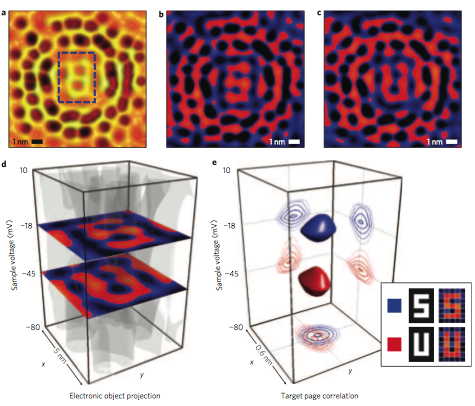Quantum holographic storage: it works!

Researchers at Stanford University have demonstrated quantum holographic storage, shattering long-held assumptions about the information limits of matter. Moving into the sub-atomic realm, they permanently stored 35 bits in the quantum space surrounding a single electron.
Moreover, the technique allows holograms to be "stacked" in 3 dimensions. They demonstrated 2 35-bit storage elements in the same space. Encoding data using mere atoms would be less than half as space efficient.
Holodeck backstory Traditional holograms - like those nifty green reflection skulls you see in trinket shops - use a laser. The laser is split into a reference beam and an object beam that has been reflected off the 3D surface you are recording.
The 2 beams are recombined and the resulting interference pattern stored in a 2D photographic emulsion. When viewed, the the hologram reproduces the object as it appeared in 3D space so it appears to rotate as it is moved.
A spin-off from Bell Labs has been working on commercial holographic storage for several years.
Quantum holography The researchers (Christopher R. Moon, Laila S. Mattos, Brian K. Foster, Gabriel Zeltzer and Hari C. Manoharan) an interdisciplinary team from the departments of Physics, Electrical Engineering and Applied Physics at Stanford, used a gas of 2D surface state electrons held on the face of a copper crystal. Using atomic manipulation the team place individual electrons in closed quantum corrals - a common research tool.
The tricky part was encoding a specific pattern around the electrons. Using simulated annealing, they controlled the amplitude and phase of the electrons to encode the bits.
Since the writing "surface" is a gas, the team was then able to encode holograms in the same space by embedding them volumetrically in 3D. Here's a picture:

A scanning tunneling microscope, a standard tool of atomic level research, was used to read the information and create the images.
iPod sub-Nano The authors conclude:
We have experimentally demonstrated that 35 bits can be permanently encoded into a time-independent fermionic state, and that two such states can be simultaneously prepared in the same area of space. . . . In all experimental attempts, extending down to the subatomic regime, the encoding was successful and the data were retrieved at 100% ?delity. We believe the limitations on bit size are [.025 of a nanometer], but surprisingly the information density can be signi?cantly boosted by using higher-energy electrons and stacking multiple pages holographically. Determining the full theoretical and practical limits of this technique — the trade-offs between information content (the number of pages and bits per page), contrast (the number of measurements required per bit to overcome noise), and the number of atoms in the hologram — will involve further work.
I hope they get the money they need to continue this research.
The Storage Bits take This is far frontiers research - not something you'll see in a commercial product in 5 years or even 25 years. But by demonstrating that quantum holography can store massive amounts of data in a very small space, the scientists have pushed out our conception of how much data mankind may eventually be able to process and store.
Comments welcome, of course. The original, highly technical, article is available online from Nature Nanotechnology (pdf).